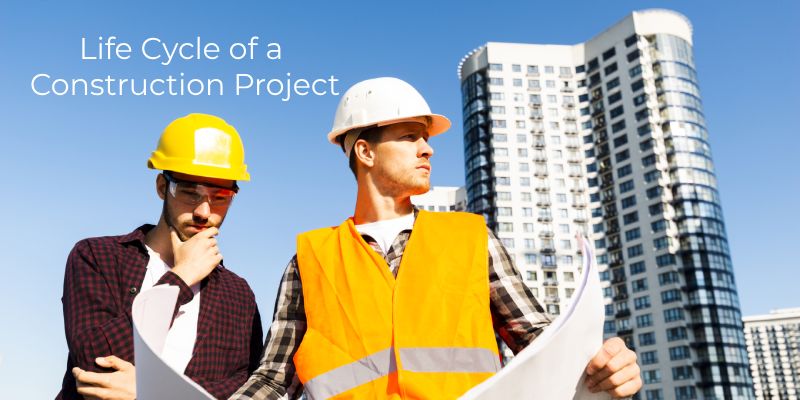The life cycle of a construction project is a complex journey that transforms a concept into a tangible structure. Each phase in this process, from planning to completion, plays a critical role in ensuring the success of the project. Understanding the steps involved can help stakeholders, whether they are property owners, contractors, or project managers, navigate the project smoothly and achieve desired outcomes.
Life Cycle of a Construction Project
The construction project life cycle involves several phases that take a project from initial concept to completion.
Let’s explore the life cycle of a construction project:
The Pre-Construction Phase
The pre-construction phase sets the foundation for the entire project, including initial planning, design, and feasibility analysis.
Initial Project Conception
Every construction project starts with an idea. The initial project conception phase involves taking that idea and outlining the goals, scope, and objectives. This is also where key stakeholders—such as the client, architects, engineers, and financiers—come together to discuss their visions and establish the project’s overall direction.
Feasibility Studies
Before beginning any work, we conduct feasibility studies to assess whether the project is viable. We thoroughly analyze the site, evaluate environmental impacts, and review local regulations. By determining the project’s feasibility, we identify and address potential challenges early on, saving time and resources later.
Design Development
Design development turns the project’s concept into detailed plans that will guide the entire construction process.
Conceptual Design
The conceptual design phase is where the initial vision for the project begins to take shape. Architects and engineers collaborate to create sketches and outlines that reflect the goals of the project. These early designs provide a framework for more detailed plans and give stakeholders an idea of what the final structure will look like.
Detailed Design
After approving the conceptual design, the team begins the detailed design phase. They create technical drawings, specifications, and plans to guide the construction process. Engineers focus on the structure, while architects maintain the aesthetic and functional aspects.
The Planning Phase
In the planning phase, you secure necessary permits, estimate costs, and create a timeline to ensure the project runs smoothly.
Securing Permits and Approvals
Before any construction can commence, the necessary permits and approvals must be secured from local authorities. This step ensures that the project complies with zoning laws, building codes, and environmental regulations.
Budgeting and Cost Estimation
A detailed budget is developed based on the project’s design and scope. This includes estimates for materials, labour, and other expenses. Proper budgeting ensures the project remains financially viable and helps avoid unexpected costs.
Project Scheduling
A clear and realistic project schedule is essential for keeping the construction process on track. Tools like Gantt charts are often used to outline tasks, set deadlines, and ensure that different phases of the project are completed in a timely manner.
The Procurement Phase
Procurement involves selecting contractors and purchasing materials, ensuring the right resources are available when needed.
Selecting Contractors and Vendors
The procurement phase involves selecting contractors, subcontractors, and suppliers who will provide the labour and materials for the project. This selection process is crucial to ensuring the quality and efficiency of the construction work.
Procurement of Materials
Choosing high-quality materials is essential for the success of any construction project. Proper quality control measures should be in place to ensure that materials meet the necessary standards and are delivered on time.
The Construction Phase
Now, your project moves from planning into action as you break ground and start building.
Site Preparation
Before construction can begin, you need to prepare the site. This typically involves clearing the land, grading, and setting up temporary utilities. Site preparation ensures that the construction area is ready for the work to begin and that there are no obstacles or hazards.
Foundation Work
Laying the foundation is one of the most critical aspects of construction. The foundation supports the entire structure and must be built with precision. Depending on the project, you might use different types of foundations, such as slab-on-grade, crawl space, or a full basement.
Structural Framing
After the foundation is complete, the structural framing begins. This is where the skeleton of the building takes shape. Depending on the project, the framing may be constructed from materials like concrete, steel, or wood.
Mechanical, Electrical, and Plumbing (MEP) Installation
MEP systems are installed during this phase to ensure the building’s functionality. These systems include heating, ventilation, air conditioning (HVAC), electrical wiring, and plumbing.
Finishing Work
As the construction nears completion, finishing work begins. This includes tasks like painting, installing flooring, and completing the exterior facade. These final touches give the building its aesthetic appeal and make it ready for occupancy.
The Post-Construction Phase
Once construction ends, you focus on ensuring everything works as intended and hand over the project to the client.
Inspections and Testing
Before the project is handed over, inspections and testing are conducted to ensure that everything meets the required standards. This includes checking the MEP systems, safety features, and structural integrity.
Final Walkthrough
The final walkthrough allows the client to inspect the building and ensure that everything meets their expectations. If any issues arise, you’ll address them before officially completing the project.
Project Handover and Closeout
Once all inspections are completed and any issues are resolved, the project is officially handed over to the client. The closeout process involves finalizing paperwork, settling any outstanding payments, and providing the client with documentation for future maintenance.
Project Maintenance and Lifecycle Management
Once completed, the building requires ongoing maintenance to ensure it remains functional and in good condition.
Facility Management
Facility management involves overseeing the building’s daily operations, including maintenance, repairs, and security. A facility manager ensures that the building remains functional and efficient.
Regular Maintenance
Regular maintenance tasks, such as cleaning, repairing, and updating systems, help prolong the lifespan of the building and prevent costly repairs in the future.
Renovations and Upgrades
Over time, renovations or upgrades may be necessary to modernize the building, improve efficiency, or meet new regulations.
Conclusion
The life cycle of a construction project is a detailed and structured process that ensures the successful completion of a project from conception to handover. Each phase, from planning and design to construction and post-completion maintenance, is crucial for delivering a high-quality, functional structure. Understanding this life cycle can help all stakeholders manage their roles effectively and ensure the project is completed on time, within budget, and to the highest standards.
FAQs
What is the most critical phase of a construction project?
The planning phase is the most critical because it lays the groundwork for the project’s success by defining budgets, schedules, and objectives.
How long does a typical construction project take from start to finish?
Depending on the scope and complexity, a construction project can take anywhere from several months to a few years.
Who are the key stakeholders in a construction project?
Key stakeholders include the project owner, architects, engineers, contractors, subcontractors, and financial backers.
What role does technology play in modern construction projects?
Technology plays a significant role in project management, design (via CAD software), scheduling, and even automating certain construction processes through machinery and drones.
What happens if a project goes over budget?
If a project exceeds its budget, the stakeholders may need to reassess the scope, secure additional funding, or find ways to cut costs without compromising quality.






